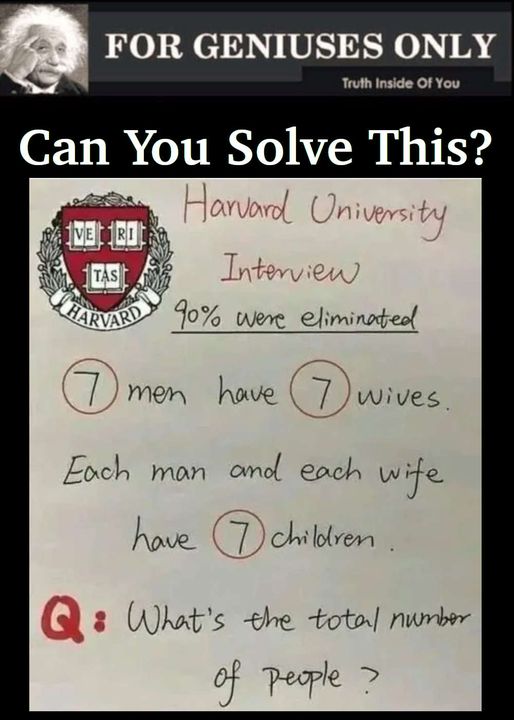Getting into Harvard is no small feat. It’s not just about having top grades or a stellar resume; it’s also about showcasing your ability to think critically under pressure. Among the various challenges an applicant might face during the interview process, one particular test has gained a reputation for separating the best from the rest: the Harvard Riddle. This seemingly simple puzzle has left many aspiring students scratching their heads, but with the right approach, you can not only solve it but also leave a lasting impression. Let’s delve into the riddle, explore its implications, and uncover strategies to master it.

Step 1: Counting the Men
The riddle starts with seven men. This is straightforward:
- Number of Men: 7
Step 2: Counting the Wives
Each of these seven men has seven wives. So:
- Number of Wives: 7 Men × 7 Wives per Man = 49 Wives
Step 3: Counting the Children
Now, let’s count the children. Each couple (man and wife) has seven children. Since we have 49 wives and each has 7 children with her husband:
- Number of Children: 49 Couples × 7 Children per Couple = 343 Children
Step 4: Adding It All Together
Finally, we need to add up all the people involved:
- 7 Men + 49 Wives + 343 Children = 399 People
Understanding the Numbers
While the math might seem basic, it’s the structure of the riddle that often leads to confusion. People might mistakenly think that the 7 children apply to the group as a whole, rather than each couple individually. But as we’ve carefully calculated, the total number of people involved is 399.
Why This Riddle Confuses So Many
One of the main reasons this riddle trips people up is because of the sheer volume of multiplication and addition required. It’s easy to overlook a step or make a mistake in multiplying the numbers correctly. Additionally, the riddle’s wording might lead some to think the children are counted differently, which adds to the confusion.
The Importance of Breaking Down Riddles
This riddle is a perfect example of why it’s essential to break down problems step by step. By carefully considering each part of the riddle and calculating one step at a time, we can arrive at the correct answer without getting overwhelmed.
How to Approach Similar Riddles
When faced with similar riddles or problems, always:
- List Out All the Elements: Write down every part of the riddle. In this case, that’s the men, the wives, and the children.
- Break Down the Math: Calculate each element separately before adding everything together.
- Double-Check Your Work: Go over your math to ensure that each step adds up correctly.
Why Riddles Matter
Riddles like this one are more than just fun brain teasers; they teach us valuable problem-solving skills. By challenging us to think critically and approach problems systematically, riddles help sharpen our minds and prepare us for more complex tasks in daily life.
The Joy of Solving Riddles
There’s a certain satisfaction that comes with solving a riddle, especially when it involves a bit of math. It’s a mental workout that’s both challenging and rewarding. Whether you’re solving it alone or with friends, figuring out the correct answer brings a sense of accomplishment.
Conclusion: The Final Count
In conclusion, when we break down the riddle of seven men, their seven wives, and their children, we find that the total number of people is 399. While the math is simple, the structure of the riddle can easily lead to confusion if not approached methodically. The key is to take it one step at a time, ensuring that every element of the problem is accounted for.
Next time you encounter a similar riddle, remember to stay calm, break it down, and enjoy the process of unraveling the mystery. Whether it’s a simple counting problem or a more complex puzzle, the skills you gain from solving riddles are invaluable.





